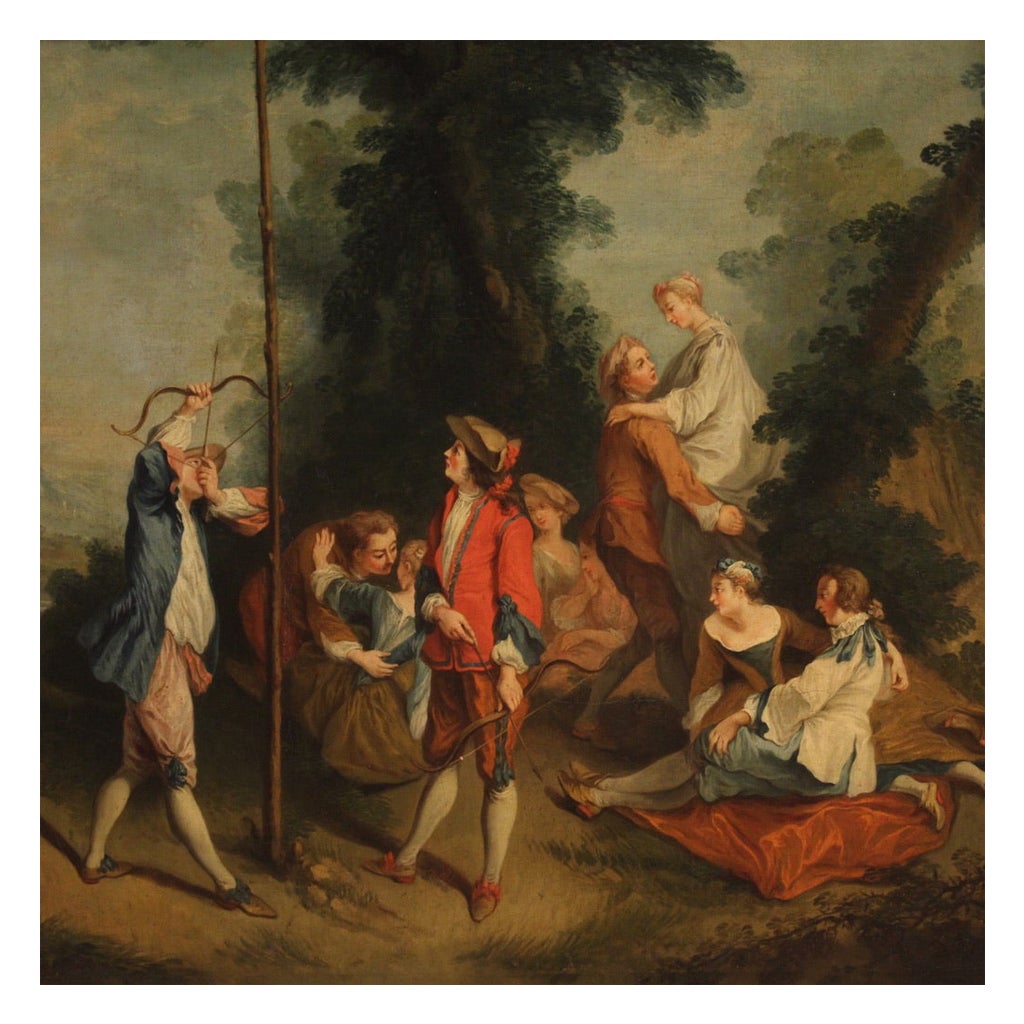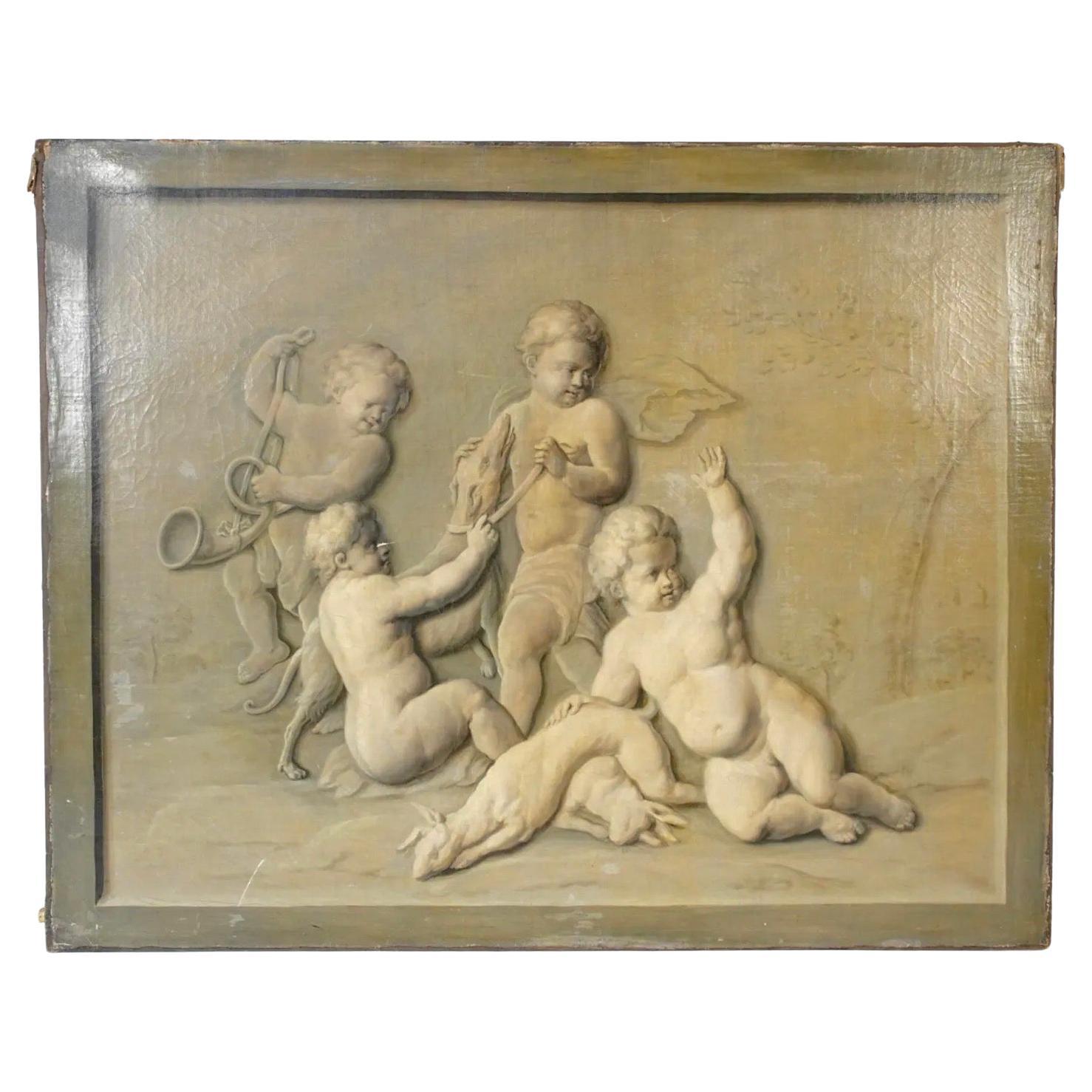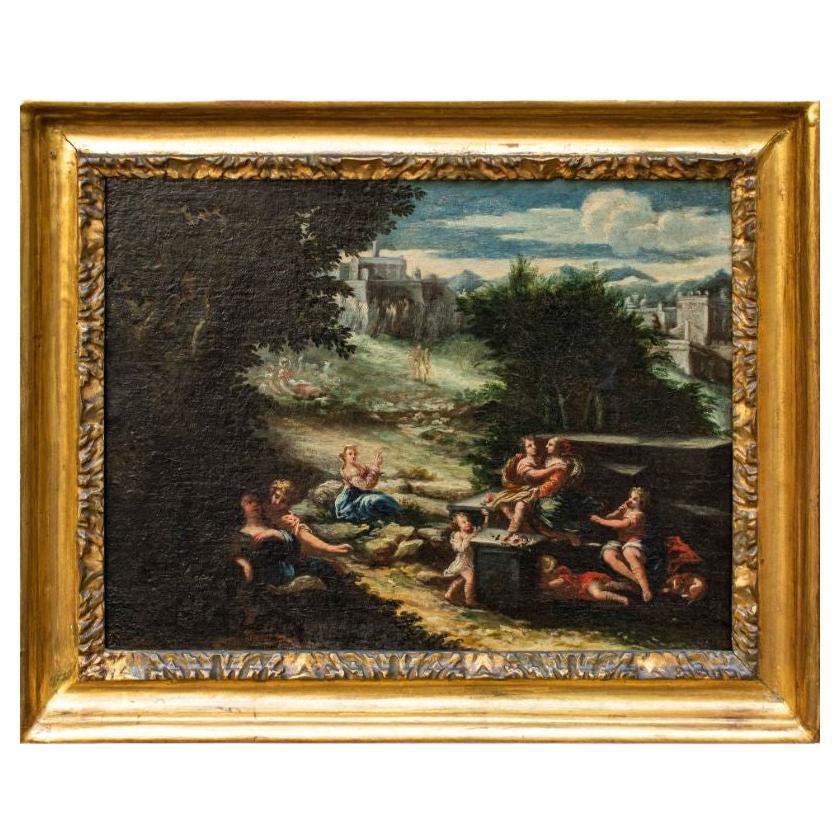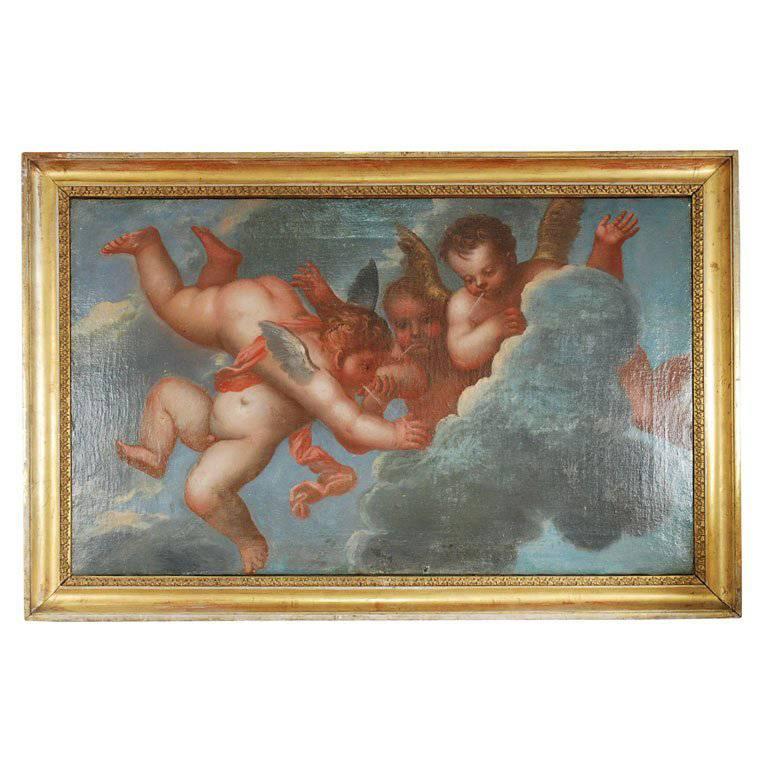Items Similar to Gallant Scene Painting by Philippe Mercier, 18th Century
Want more images or videos?
Request additional images or videos from the seller
1 of 9
Gallant Scene Painting by Philippe Mercier, 18th Century
About the Item
An 18th century painting of a gallant scene in a park.
Attributed with seal of painter's studio to Philippe Mercier (1689 to 1760) from the circle of the french painter Nicolas Lancret, a follower of the École of Antoine Watteau.
Oil on canvas, in a fine carved giltwood frame.
Frame:
Width: 16,53 in (42 cm)
Depth: 14,56 in (37 cm)
Canvas:
Width: 12,99 in (33 cm)
Depth: 10,62 in (27 cm)
Philippe Mercier (Berlin 1689 – London 1760) born in Berlin and studied at the Berlin Akademie with Antoine Pesne before traveling to Italy and France. By the time he arrived in London in 1716, had considerable familiarity with the work of contemporary French painters, particularly Watteau and his sophisticated style. Soon won Watteau patronage in court circles.
In 1726 painted two important group portraits that can be seen as an introduction to English art - Baron Schultz and his friends (1725, Tate Gallery, London) and Viscount Tyrconnel with his family (1725-6, private collection).
In 1729, Mercier was appointed Chief Painter to Frederick, Prince of Wales, and, a year later, keeper of his library, but they seem to have fallen away in the latter half of the 1730s, when he retired to the country, where painted several portraits for the Samwell family of Upton, Northants, and Hesilriges of Noseley, Warwicks.
In 1739 Mercier moved to York, where he built up a considerable portrait practice among
the leading families in the county. It was at this time that he made his greatest contribution to British painting, introducing and developing the 'extravagant image', a genre derived from Chardin as well as Watteau and 17th-century Dutch genre painting.
Described by George Vertue as "bit of some conversational figures as large as life: vain plaisant Fantasies and habits: mixed modes very well done – and very approved", such works were frequently recorded and clearly enjoyed considerable success.
Painted in the second half of the 1730s, the present work, An Allegory of Taste, is a fine example of this way of painting and its Rococo sensibility reveals the artist's affinities with contemporary French art.
Mercier would return to the theme of the five senses in a series of large canvases executed in the mid-1740s Mellon Collection, Yale Center for British Art.
Although later works are more complex in their treatment of subjects, they lack the charm and lightness of handling encountered in the present composition.
About the Seller
5.0
Vetted Seller
These experienced sellers undergo a comprehensive evaluation by our team of in-house experts.
Established in 2023
1stDibs seller since 2023
Typical response time: 1 hour
- ShippingRetrieving quote...Ships From: Porto, Portugal
- Return PolicyA return for this item may be initiated within 2 days of delivery.
More From This SellerView All
- Painting Lake Garda Italian School 18th CenturyLocated in Lisbon, PTA grand view of an Italian lake, tower with the lake Garda (other name Benaco) and boats in the background. An Italian School from XVIII Century. Frame with glass. Frame: Width: ...Category
Antique 18th Century Italian Baroque Paintings
MaterialsWood, Paper
- Saint Joseph Jesus Baroque Painting, 18th CenturyLocated in Lisbon, PTA 17th Century painting of Joseph with the Child Jesus on his lap, a rare Baroque motif of paternal love. Oil on wood Frame: 47x54 cm Without frame: 27x34 cmCategory
Antique 18th Century Italian Baroque Paintings
MaterialsWood
- Baroque Painting, Loving Couple, Watteau School, 18th CenturyLocated in Lisbon, PTThis signed 18th Century painting showcases a beautiful scene of a loving man and woman and their loyal canine companion gathered around a charming fountain, executed in the Baroque ...Category
Antique 18th Century French Baroque Paintings
MaterialsCanvas
- Saint Paul Italian School Painting 18th Century Religious ArtLocated in Lisbon, PTA Saint Paul of Tarsus Painting, also called Apostle Paul, Saul of Tarsus, Saint Paul the Apostle or Apostle of the Gentiles. The sword in Saint Paul's hand symbolizes the way he wa...Category
Antique 18th Century Italian Baroque Paintings
MaterialsCopper
- Painting Saint John The Baptist Child Jesus, 18th CenturyLocated in Lisbon, PTA Flemish School painting of the Adoration of the Child Jesus in the hands of Mary and a young Saint John the Baptist at his feet kneeling with the cross side by side with a resting ...Category
Antique 18th Century Dutch Baroque Paintings
MaterialsWood
- Italian Painting The Adoration of the Magi, 18th Century Religious ArtLocated in Lisbon, PTA biblical scene of the Adoration of the Magi of the baby Jesus, depicting the meeting between the mysterious travelers and the Family. An Italian painting of deep light contrast an...Category
Antique 18th Century Italian Baroque Paintings
MaterialsCanvas
You May Also Like
- 18th Century Oil on Canvas French Antique Gallant Genre Scene Painting, 1770Located in Vicoforte, PiedmontAntique French painting from the second half of the 18th century. Oil on canvas artwork depicting a gallant party in the woods, genre scene with characters in the style of Jean-Honor...Category
Antique Late 18th Century French Paintings
MaterialsCanvas
- 18th Century French Grisaille Painting of Putti in Hunting SceneLocated in Essex, MAEarly 18th Century French Oil on Canvas Grisaille of Putti in a Hunting Scene. Gray-green tones, sculptural looking putti in a landscape with auct...Category
Antique 18th Century French Baroque Paintings
MaterialsPaint
- 17th Century Oil on Oak Panel Flemish Gallant Scene Painting, 1670Located in Vicoforte, PiedmontAntique Flemish painting from the second half of the 17th century. Oil on oak panel depicting Musicians, elegant duet with lute player and hunting scene in ...Category
Antique Late 17th Century Belgian Paintings
MaterialsOak
- 17th Century Rural Landscape with Gallant Scenes Painting Oil on CanvasLocated in Milan, IT17th century, Emilian school Rural landscape with gallant scenes Oil on canvas, 37 x 47.5 cm With frame 61 x 50.5 cm The bucolic amenity of the present is reflected in the joyful gallant scenes that dot its surface. The locus amoenus described reflects on the more traditional inflection of Arcadia, which in the literary transfiguration was the scenario par excellence of the most carefree pastoral life and out of this world; the painting is therefore a forerunner of what was professed by the actual poetic academy of Arcadia which was established in Rome in 1690, but enthusiastically testifies to the feverish invitations to its acceptance, then widespread in the most avant-garde cultural salons throughout Italy. First Theocritus and Virgil later had awakened with Idilli and Bucoliche that capacity typical of the natural world to allow an escape from reality; the contemplation of perfect natural fruits that followed would have evoked in the spirits of dreaming men back to origins. The bucolic landscape was able to positively give a rhythm to material life, and constituted the concretization of a place devoid of incivility and ugliness, where only dreams, wild music and homages to fruitful nature were allowed. In the present painting widespread figures of shepherd children trace the same intent to the sublimation of earthly life, gathered in pairs, while children on the model of the ancient cherubs cheer the field with flowers and petals. The games of these and the sweet affections of the other characters are rendered through liquid and vibrant brushstrokes, flickering with a white light that opposes the dark shadow of the undergrowth. In the distance, the sky tapers with a silvery and flat brushstroke, while the vertical development of the promoters with architectures helps to introject a bright beam of light into the grassy clearing. The foliage and the turf of the landscape piece are rendered through a digital brushstroke, betraying the Italian brand of the present, influenced at the same time by the seventeenth-century European influences that then conveyed to the capital. The evocative culture of the city attracted many artists from the city of Bologna, from the Italian north but also from the territories beyond the Alps, such as Claude Lorrain and Nicolas Poussin. The historical-artistic heritage of the Italian pastoral scenes was thus able to fill up with the more functional and particular formalisms of the charms coming from elsewhere, such as the expressive tremor of the present, similar to the contemporary French lexicon. The typological restitution from pastoral idyll, in accordance with the intrinsic stylistic qualities of the work, allows us to specify the solid belonging of the present to the Italian hand, similarly to what was then emerging in the pictorial sphere within the Emilian school. In this regard, we should recall the latent influences of two decisive foreign landscape painters who passed through the Emilian belt, such as Claude Lorrain (1600-1682) and Nicolas Poussin (1594-1665); before them, Giovanni Battista Viola...Category
Antique 17th Century Italian Paintings
MaterialsCanvas
- 17th-18th Century Venetian PaintingLocated in Pembroke, MAVenetian School painting of four angels, allegorically depicting the variable winds of change and time. Unsigned, believed to be by a follower of Pietro Li...Category
Antique 17th Century Italian Baroque Paintings
MaterialsGiltwood, Canvas
- 18th Century Convivial Scene Painting Oil on Canvas by Pietro FabrisLocated in Milan, ITAttr. to Pietro Fabris (active in Naples, 1756 - 1792) Convivial scene Oil on canvas, 63 X 75 cm The canvas in question depicts a joyful banquet scene with characters dressed in traditional clothes typical of southern Italy, similar to Pietro Fabris. Much biographical information is lacking on this painter who was active in Naples between 1756 and 1792. It is assumed that he was of English origin, since he himself in many paintings is signed, next to his name, "English painter". Also appreciated in England, Fabris in 1768 exhibited in London at the Free Society and in 1772 at the Society of Artist. His vast known artistic production must therefore be included between the date of 1756, affixed to a Neapolitan scene (London, Trafalgar Galleries: see Spinosa, 1987, p. 162), and that of 1792, execution of the Pilgrimage to the sanctuary of the Madonna dell 'Arco (antiques market, formerly Matthiesen, London, published in Spinosa, 1987, fig. 410). This production includes numerous oils on canvas, gouaches and drawings, inspired by Neapolitan views and landscapes and popular scenes, festivals and costumes of southern Italy. In the initial phase, references to Carlo Bonavia and Gabriele Ricciardelli are marked, later enriched by collusions with the scenographic landscape painting of Antonio Joli...Category
Antique 18th Century Italian Paintings
MaterialsCanvas





